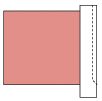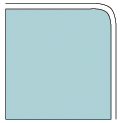Without Binding - Self-Finish
There is one way to eliminate adding an edge finish. This is done before quilting. Place the batting on a flat surface. Place the pieced top right side up on the batting. Place the backing right sides together with the pieced top. Pin and/or baste the layers together to hold flat.
Begin stitching in the center of one side using a 1/4" seam allowance, reversing at the beginning and end of the seam. Continue stitching all around and back to the beginning side. Leave a 12" or larger opening. Clip corners to reduce excess. Turn right side out through the opening. Slipstitch the opening closed by hand. The quilt may now be quilted by hand or machine.
The disadvantage to this method is that once the edges are sewn in, any creases or wrinkles that might form during the quilting process cannot be flattened out. Tying is the preferred method for finishing a quilt constructed using this method.
Bringing the backing fabric to the front is another way to finish the quilt's edge without binding. To accomplish this, complete the quilt as for hand or machine quilting. Trim the batting only even with the front. Trim the backing 1" larger than the completed top all around.
Turn the backing edge in 1/2" and then turn over to the front along edge of batting. The folded edge may be machine-stitched close to the edge through all layers, or blind-stitched in place to finish.
The front may be turned to the back. If using this method, a wider front border is needed. The backing and batting are trimmed 1" smaller than the top and the top edge is turned under 1/2" and then turned to the back and stitched in place.
One more method of self-finish may be used. The top and backing may be stitched together by hand at the edge. To accomplish this, all quilting must be stopped 1/2" from the quilt-top edge. The top and backing of the quilt are trimmed even and the batting is trimmed to 1/4" - 1/2" smaller. The edges of the top and backing are turned in 1/4" - 1/2" and blind-stitched together at the very edge.
These methods do not require the use of extra fabric and save time in preparation of binding strips; they are not as durable as an added binding.
Binding
The technique of adding extra fabric at the edges of the quilt is called binding. The binding encloses the edges and adds an extra layer of fabric for durability.
To prepare the quilt for the addition of the binding, trim the batting and backing layers flush with the top of the quilt using a rotary cutter and ruler or shears. Using a walking-foot attachment (sometimes called an even-feed foot attachment), machine-baste the three layers together all around approximately 1/8" from the cut edge.
The list of materials given with each quilt often includes a number of yards of self-made or purchased binding. Bias binding may be purchased in packages and in many colors. The advantage to selfmade binding is that you can use fabrics from your quilt to coordinate colors.
Double-fold, straight-grain binding and double-fold, bias-grain binding are two of the most commonly used types of binding. Double-fold, straight-grain binding is used on smaller projects with right-angle corners. Double-fold, biasgrain binding is best suited for bed-size quilts or quilts with rounded corners.
To make double-fold, straightgrain binding, cut 2"-wide strips of fabric across the width or down the length of the fabric totaling the perimeter of the quilt plus 10". The strips are joined as shown in Figure 17 and pressed in half wrong sides together along the length using an iron on a cotton setting with no steam.
 |
|
Figure 17
Join binding strips in a diagonal seam to eliminate bulk as shown. |
Lining up the raw edges, place the binding on the top of the quilt and begin sewing (again using the walking foot) approximately 6" from the beginning of the binding strip. Stop sewing 1/4" from the first corner, leave the needle in the quilt, turn and sew diagonally to the corner as shown in Figure 18.
 |
|
Figure 18
Sew to within 1/4" of corner; leave needle in quilt, turn and stitch diagonally off the corner of the quilt. |
Fold the binding at a 45-degree angle up and away from the quilt as shown in Figure 19 and back down flush with the raw edges. Starting at the top raw edge of the quilt begin sewing the next side as shown in Figure 20. Repeat at the next three corners.
 |
|
Figure 19
Fold binding at a 45-degree angle up and away from quilt as shown. |
 |
|
Figure 20
Fold the binding strips back down, flush with the raw edge, and begin sewing. |
As you approach the beginning of the binding strip, stop stitching and overlap the binding 1/2" from the edge; trim. Join the two ends with a 1/4" seam allowance and press the seam open. Reposition the joined binding along the edge of the quilt and resume stitching to the beginning.
To finish, bring the folded edge of the binding over the raw edges and blind-stitch the binding in place over the machine-stitching line on the backside. Hand-miter the corners on the back as shown in Figure 21.
 |
|
Figure 21
Miter and stitch the corners as shown. |
If you are making a quilt to be used on a bed, you will want to use double-fold, bias-grain bindings because the many threads that cross each other along the fold at the edge of the quilt make it a more durable binding.
Cut 2"-wide bias strips from a large square of fabric. Join the strips as illustrated in Figure 17 and press the in seams open. Fold the beginning end of the bias strip 1/4" from the raw edge and press. Fold the joined strips in half along the long side, wrong sides together, and press with no steam (Figure 22).|
|
|
Figure 22
Fold end in and press strip in half. |
Follow the same procedures as previously described for preparing the quilt top and sewing the binding to the quilt top. Treat the corners just as you treated them with straight-grain binding.
Since you are using biasgrain binding, you do have the option to just eliminate the corners if this option doesn't interfere with the patchwork in the quilt. Round the corners off by placing one of your dinner plates at the corner and rotary cutting the gentle curve (Figure 23).
 |
|
Figure 23
Round corners to eliminate square-corner finishes. |
As you approach the beginning of the binding strip, stop stitching and lay the end across the beginning so it will slip inside the fold. Cut the end at a 45-degree angle so the raw edges are contained inside the beginning of the strip (Figure 24). Resume stitching to the beginning. Bring the fold to the back of the quilt and hand-stitch as previously described.
![]()
End the binding strips as shown.
Overlapped corners are not quite as easy as rounded ones, but a bit easier than mitering. To make overlapped corners, sew binding strips to opposite sides of the quilt top. Stitch edges down to finish. Trim ends even.
Sew a strip to each remaining side, leaving 1 1/2" - 2" excess at each end. Turn quilt over and fold end in even with previous finished edge as shown in Figure 25.
Fold binding in toward quilt and stitch down as before, enclosing the previous bound edge in the seam as shown in Figure 26. It may be necessary to trim the folded-down section to reduce bulk.
 |
|
Figure 25
Fold end of binding even with previous edge. |
 |
|
Figure 26
An overlapped corner is not quite as neat as a mitered corner. |